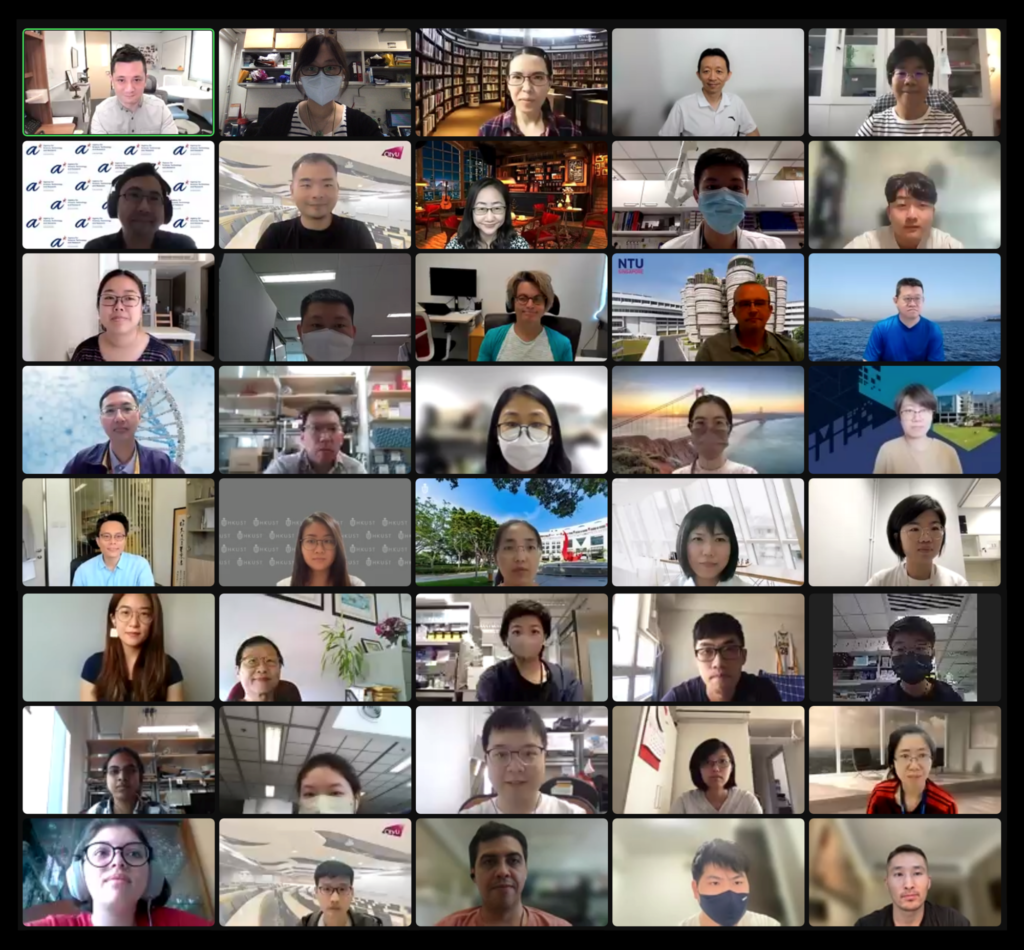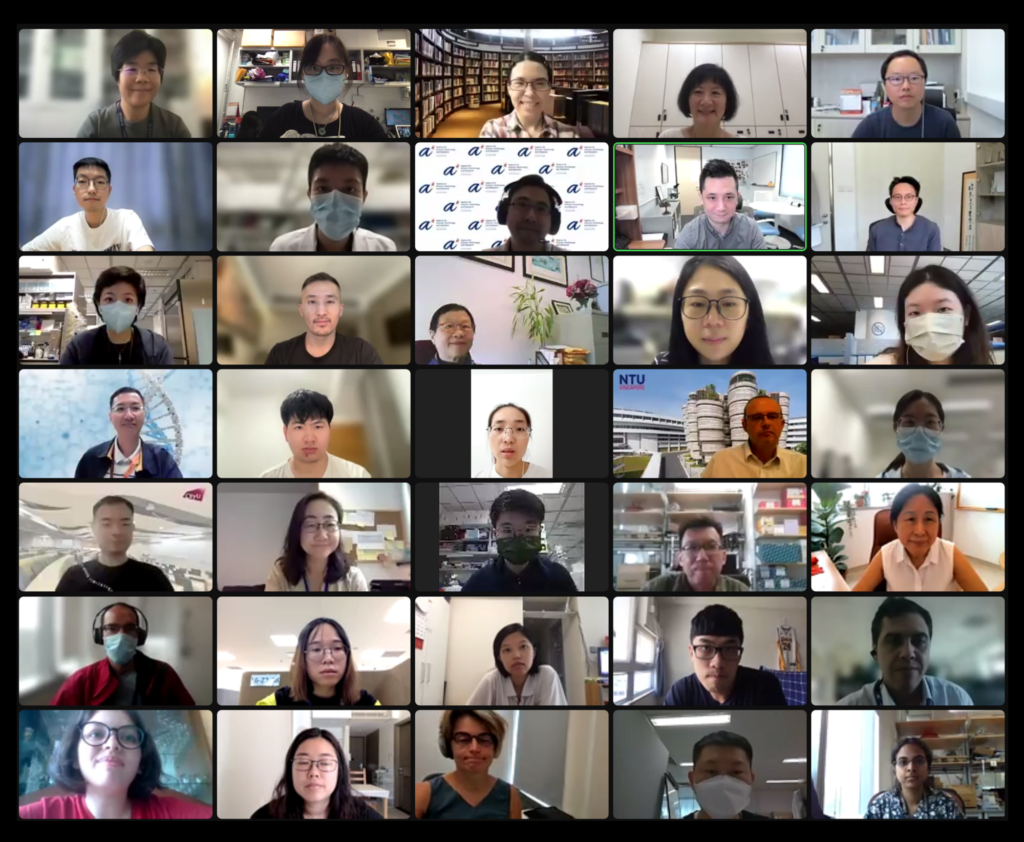EpiHK-CSI-NUS-SBS-NTU_2022
Highlights:
EpiHK-CSI NUS-SBS NTU
2022 Joint Symposium
July 25-26, 10:00am-5:00pm
via Zoom

Supported by
The Lo Ka Chung Charitable Foundation
The EpiHK-CSI NUS-SBS NTU 2022 Joint Symposium was held via Zoom on July 25th and 26th. Titled “Epigenomics and RNA in Human Health and Disease”, the two-day conference featured exciting presentations from both principal investigators and trainees from multiple institutions.

The first day began with opening remarks from the symposium hosts, Prof. Danny Leung and Prof. Melissa Fullwood, giving a warm welcome to all the speakers and attendees.
Prof. Wei Xie of Tsinghua University, the first plenary speaker, started the scientific discourse with “Resetting the Life Clock in Early Development”. He regaled the audience with his extensive knowledge about epigenetic reprogramming in embryos, talking about the extensive erasure of parental epigenetic memory after fertilization and the establishment of embryo identities through the combined actions of maternal and embryonic factors. He also spoke about Ribo-lite, an ultrasensitive Ribo-seq method which allows identification of putative maternal regulators for early embryos. He ended the presentation talking about how cross-species comparison helps uncover conserved principles of reprogramming underlying distinct strategies.

Phoebe Tam from Prof. Danny Leung’s lab at The Hong Kong University of Science and Technology presented “Cell-type differential targeting of SETDB1 prevents aberrant CTCF binding, chromatin looping, and cis-regulatory interactions”, in which she showcased her extraordinary work on the role of H3K9me3 in transcription regulation through the maintenance of chromatin interactions.
In “Novel NF-κB Transcription Factor”, Prof. Vinay Tergaonkar from the Agency for Science, Technology and Research and the National University of Singapore, presented his compelling findings about p52:ETS1, a new NF-κB family member with physiological functions.
Liu Bee Hui from Prof. Daniel Tenen’s lab at the Cancer Science Institute of Singapore gave a fascinating talk titled “A Functional SALL4 Degrader”, in which she briefed us on the role of SALL4 in cancers and how its degradation can result in cancer cell death.
In “Profiling transposable element expression provides insights of immune infiltration and prognosis in colorectal cancer”, Prof. Jason Wong from The University of Hong Kong gave an intriguing presentation about how transposable elements expression is associated with immune overdrive and is a potential biomarker for immune checkpoint blockade.
Kelly Yichen Li from Prof. Kevin Yip’s lab at The Chinese University of Hong Kong with “Regulatory roles of the three-dimensional structures of topologically associating domains” demonstrated how the intra-TAD ratio appears to be a proxy of TAD 3D structures and that regions with lower intra-TAD ratio are more active than TAD cores.

Prof. Melissa Fullwood from Nanyang Technological University and the Cancer Science Institute of Singapore with “Investigating the 3D genome organization of silencers in regulating gene transcription” delivered a thought-provoking presentation on super-silencers, regions with long stretches of high H3K27me3 levels, and how different silencers can work together in a synergistic manner, potentially through chromatin interactions.
Prof. Jian Yan from City University of Hong Kong in ”The mechanism of DNA hypomethylation around CTCF binding sites” gave an engrossing presentation on CTCF and it’s preference for methylated DNA, recruitment of TET likely via the NuRD complex, and subsequent induction of DNA demethylation.
Prof. Meizhen Zheng from Southern University of Science and Technology graciously presented “Single-molecule multi-way chromatin interaction visualization and micro-domains identification” in which she introduced MCIBox, a toolkit for multi-way chromatin interaction analysis which includes a visualization tool and platform for identifying micro-domains with clustered single-molecule chromatin complexes.
Haoqing Shen from Prof. Polly Leilei Chen’s lab at the Cancer Science Institute of Singapore in “RNA Editing Enzymes Function as Potent Regulators on the Circular Transcriptome in Cancer” spoke about how ADAR1/2 regulates circular RNAs in both directions via editing-dependent and/or independent mechanism, and how that can lead to functional molecules influencing tumorigenesis.
The final presentation of the day was “scONE-seq: A novel single-cell multi-omics method enables simultaneous dissection of DNA and RNA heterogeneity from frozen tumors” charismatically given by Prof. Angela Wu from The Hong Kong University of Science and Technology. She shared a novel method called scONE-seq which allows WGS and RNA-seq from same cell in a single one-tube reaction and her data connecting the phenotype and genotype of glioblastoma.

Our second plenary speaker, Prof. Chia-Lin Wei from The Jackson Laboratory, started off the second day of the symposium with her riveting presentation “Strategies for multi-omic mapping of 3D epigenomes in cancer”. Many different projects, experiments and methods were mentioned including ChIA-PIPE, a fully automated pipeline for comprehensive ChIA-PET data analysis and visualization. The intriguing concept of extrachromosomal circular DNA as a cancer promoting agent through the creation of active super-enhancer sites were also discussed. Additionally, she mentioned a thrilling new method called ChIATAC, an unbiased chromatin interaction assay for open chromatin interaction in <5k cells.

Yuwei Zhang from Prof. Hao Sun’s and Prof. Huating Wang’s labs at The Chinese University of Hong Kong in “Transcriptomic RNA Structure Mapping Unveils the Structure Dynamics Induced by DHX36 Binding” presented on the effects of DEAH-BOX Helicase 36 (DHX36) binding to RNA which leads to 3’UTR structure loss and subsequently a decrease in post-translational mRNA.
Prof. David Li from The University of Hong Kong presented epigenetics from a chemist’s point of view in “Chemical approaches to decipher histone modifications”, covering problems such as potentially weak histone post-translational-modification mediated protein-protein interactions and identifying erasers or other transient interactions.
Prof. Daniel Tenen from Harvard and the Cancer Science Institute of Singapore presented his engaging talked titled “Weird nuclear noncoding RNAs regulating DNA methylation and mRNA transcription”, in which he displayed his vast and diverse knowledge, mentioning a new method called CRISPR-DiR (DNMT1-interacting RNA) used to explore gene specific methylation and activation, his projects involving SALL4, a oncofetal protein that is a great therapeutic target, and his studies on the role of early S phase RNA (SPEARs).
Prof. Danny Leung from The Hong Kong University of Science and Technology delivered an intriguing talk with “Epigenomic dysregulation of retrotransposons in the placenta” in which he spoke about the association between retrotransposon dysregulation and pregnancy complications such as preeclampsia and the potential effects of SARS-CoV-2 infection during pregnancy on LTR-derived enhancers in the maternal-fetal interface.
Semih Akincilar from Prof. Vinay Tergaonkar’s lab at the Agency for Science, Technology and Research with “Epigenetic switch to turns on cancer immortality” flawlessly discussed the two-step hTERT reactivation mechanism which enables expression and how disruption of chromatin structures switches off hTERT promoter activity.

In “Epigenetic restoration of intra-tumoral IFNγ signaling to overcome immune checkpoint blockade resistance in hepatocellular carcinoma”, Yalin Tu from Prof. Alfred Cheng’s lab at The Chinese University of Hong Kong knowledgably spoke about a combination treatment for HCC of CXD101, a HDAC inhibitor, and anti-PD-(L)1, a checkpoint inhibitor, which epigenetically re-activates tumoral IFNγ signaling and synergistically eradicates tumor and prolongs patient survival.
Prof. Tee Wee Wei from Agency for Science, Technology and Research and the National University of Singapore presented “Epigenetic plasticity in early development and cancer” in which he proposed NELF as an embryonic factor that is reactivated in cancer that partners with histone acetyltransferase KAT2B to promote gene activation and NELF-KAT2B may represent an important therapeutic vulnerability in metastatic cancers
Prof. Huating Wang from The Chinese University of Hong Kong gave an enthralling talk with “Multiscale 3D genome reorganization during skeletal muscle stem cell lineage progression and muscle aging”, presenting a comprehensive view of 3D genome organization in stem cell lineage progression and aging.
Sindy Tam from Prof. Angela Wu’s lab at The Hong Kong University of Science and Technology presented “Single Nuclei Transcriptomic Atlas of Young and Old Mouse Brains”, sharing a resource for the neuroscience community for future study of age-related diseases in brain and potential targets for modifying the effect of aging on adult neurogenesis.
The last presentation of our symposium was given by Prof. Xavier Roca from Nanyang Technological University, who presented “Splicing factors with disordered regions regulate GC-rich splicing events relevant for human myeloid cells”, sharing his fascinating work investigating the role of PRPF40A/B in acute myeloid leukemia and myeloid cell differentiation.
This concluded our event (our first collaborative symposium) and we would like to thank all the speakers and participants for the great exchanges in scientific insights and findings. We are already looking forward to the next symposium where we will have more up and coming research ideas in the field of epigenomics!
Live long and prosper. Thank you!


